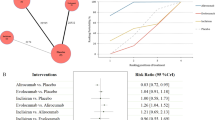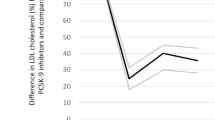Abstract
Osteoporosis and hyperlipidemia are closely correlated and statins might be associated with a decreased risk of fracture. We aimed to investigate the association between proprotein convertase subtilisin/kexin type 9 inhibitors (PCSK9i) therapy and the risk of fracture. The PubMed, Cochrane library, and EMBASE databases were systematically searched from the inception dates to October 22, 2022. Randomized clinical trials (RCTs) that addressed to fracture events of participants using alirocumab, evolocumab, bococizumab or inclisiran, with a follow-up of ≥ 24 weeks were included. Meta-analyses were conducted to calculate the odds ratio (OR) with 95% confidence intervals (CIs) for major osteoporotic fracture, hip fracture, osteoporotic non-vertebral fracture, and total fracture. 30 trials assessing PCSK9i among 95, 911 adults were included. There were no significant associations between PCSK9i therapy and the risk of major osteoporotic fracture [OR 1.08 (95% Cl 0.87–1.34), p = 0.49], hip fracture [OR 1.05 (95% Cl 0.73–1.53), p = 0.79], osteoporotic non-vertebral fracture [OR 1.03 (95% Cl 0.80–1.32), p = 0.83], and total fracture [OR 1.03 (95% Cl 0.88–1.19), p = 0.74] over a period of 6–64 months. No significant associations were detected in any of the sensitivity analyses and subgroup analyses stratified by the type of PCSK9i, follow-up duration, age, sex, sample size, and patient profile. Pooled results of our meta-analysis showed that exposure to PCSK9i was not associated with reduced risks of fracture in the short term.



Similar content being viewed by others
Data Availability
All data relevant to the study are included in the article or uploaded as supplementary information. This paper is a systematic review and does not report novel primary data.
References
Consensus development conference (1993) diagnosis, prophylaxis, and treatment of osteoporosis. Am J Med 94(6):646–650. https://doi.org/10.1016/0002-9343(93)90218-e
Blake J et al. (2021) Management of osteoporosis in postmenopausal women: the 2021 position statement of the North American menopause society’’ editorial panel. Management of osteoporosis in postmenopausal women: the 2021 position statement of the North American menopause society. Menopause 28(9):973–997
Pelton K, Krieder J, Joiner D, Freeman MR, Goldstein SA, Solomon KR (2012) Hypercholesterolemia promotes an osteoporotic phenotype. Am J Pathol 181(3):928–936. https://doi.org/10.1016/j.ajpath.2012.05.034
Orozco P (2004) Atherogenic lipid profile and elevated lipoprotein (a) are associated with lower bone mineral density in early postmenopausal overweight women. Eur J Epidemiol 19(12):1105–1112. https://doi.org/10.1007/s10654-004-1706-8
Kim J, Ha J, Jeong C, Lee J, Lim Y, Jo K, Kim MK, Kwon HS, Song KH, Baek KH (2022) Bone mineral density and lipid profiles in older adults: a nationwide cross-sectional study. Osteoporos Int. https://doi.org/10.1007/s00198-022-06571-z
Xiao F, Peng P, Gao S, Lin T, Fang W, He W (2022) Inverse association between low-density lipoprotein cholesterol and bone mineral density in young- and middle-aged people: the NHANES 2011–2018. Front Med (Lausanne) 9:929709. https://doi.org/10.3389/fmed.2022.929709
Tian L, Yu X (2015) Lipid metabolism disorders and bone dysfunction–interrelated and mutually regulated (review). Mol Med Rep 12(1):783–794. https://doi.org/10.3892/mmr.2015.3472
Kim SY, Yoo DM, Min C, Kim JH, Kwon MJ, Kim JH, Choi HG (2021) Association between osteoporosis and previous statin use: a nested case-control study. Int J Environ Res Public Health 18(22):11902. https://doi.org/10.3390/ijerph182211902
Leutner M, Matzhold C, Bellach L, Deischinger C, Harreiter J, Thurner S, Klimek P, Kautzky-Willer A (2019) Diagnosis of osteoporosis in statin-treated patients is dose-dependent. Ann Rheum Dis 78(12):1706–1711. https://doi.org/10.1136/annrheumdis-2019-215714
Cohen JC, Boerwinkle E, Mosley TH Jr, Hobbs HH (2006) Sequence variations in PCSK9, low LDL, and protection against coronary heart disease. N Engl J Med 354(12):1264–1272. https://doi.org/10.1056/NEJMoa054013
Gallego-Colon E, Daum A, Yosefy C (2020) Statins and PCSK9 inhibitors: a new lipid-lowering therapy. Eur J Pharmacol 878:173114. https://doi.org/10.1016/j.ejphar.2020.173114
Sabatine MS (2019) PCSK9 inhibitors: clinical evidence and implementation. Nat Rev Cardiol 16(3):155–165. https://doi.org/10.1038/s41569-018-0107-8
Stoekenbroek RM, Kastelein JJP (2018) Proprotein convertase subtilisin/kexin type 9: from genetics to clinical trials. Curr Opin Cardiol 33(3):269–275. https://doi.org/10.1097/HCO.0000000000000517
Ridker PM, Tardif JC, Amarenco P et al (2017) Lipid-Reduction variability and antidrug-antibody formation with bococizumab. N Engl J Med 376(16):1517–1526. https://doi.org/10.1056/NEJMoa1614062
Sterne JAC, Savović J, Page MJ, Elbers RG, Blencowe NS, Boutron I, Cates CJ, Cheng HY, Corbett MS, Eldridge SM, Emberson JR, Hernán MA, Hopewell S, Hróbjartsson A, Junqueira DR, Jüni P, Kirkham JJ, Lasserson T, Li T, McAleenan A, Reeves BC, Shepperd S, Shrier I, Stewart LA, Tilling K, White IR, Whiting PF, Higgins JPT (2019) RoB 2: a revised tool for assessing risk of bias in randomised trials. BMJ 366:l4898. https://doi.org/10.1136/bmj.l4898
Esposito K, Capuano A, Sportiello L, Giustina A, Giugliano D (2013) Should we abandon statins in the prevention of bone fractures? Endocrine 44(2):326–333. https://doi.org/10.1007/s12020-013-9924-z
Tintut Y, Demer LL (2014) Effects of bioactive lipids and lipoproteins on bone. Trends Endocrinol Metab 25(2):53–59. https://doi.org/10.1016/j.tem.2013.10.001
Papapanagiotou A, Siasos G, Kassi E, Gargalionis AN, Papavassiliou AG (2015) Novel inflammatory markers in hyperlipidemia: clinical implications. Curr Med Chem 22(23):2727–2743. https://doi.org/10.2174/0929867322666150520095008
Catapano AL, Pirillo A, Norata GD (2020) New pharmacological approaches to target PCSK9. Curr Atheroscler Rep 22(7):24. https://doi.org/10.1007/s11883-020-00847-7
Ruscica M, Tokgözoğlu L, Corsini A, Sirtori CR (2019) PCSK9 inhibition and inflammation: a narrative review. Atherosclerosis 288:146–155. https://doi.org/10.1016/j.atherosclerosis.2019.07.015
Wu NQ, Shi HW, Li JJ (2022) Proprotein convertase subtilisin/kexin type 9 and inflammation: an updated review. Front Cardiovasc Med 9:763516. https://doi.org/10.3389/fcvm.2022.763516
Ricci C, Ruscica M, Camera M, Rossetti L, Macchi C, Colciago A, Zanotti I, Lupo MG, Adorni MP, Cicero AFG, Fogacci F, Corsini A, Ferri N (2018) PCSK9 induces a pro-inflammatory response in macrophages. Sci Rep 8(1):2267. https://doi.org/10.1038/s41598-018-20425-x.PMID:29396513;PMCID:PMC5797178
Pradhan AD, Aday AW, Rose LM, Ridker PM (2018) Residual inflammatory risk on treatment with PCSK9 inhibition and statin therapy. Circulation 138(2):141–149. https://doi.org/10.1161/CIRCULATIONAHA.118.034645
Bohula EA, Giugliano RP, Leiter LA, Verma S, Park JG, Sever PS, Lira Pineda A, Honarpour N, Wang H, Murphy SA, Keech A, Pedersen TR, Sabatine MS (2018) Inflammatory and cholesterol risk in the fourier trial. Circulation 138(2):131–140. https://doi.org/10.1161/CIRCULATIONAHA.118.034032
An T, Hao J, Sun S, Li R, Yang M, Cheng G, Zou M (2017) Efficacy of statins for osteoporosis: a systematic review and meta-analysis. Osteoporos Int 28(1):47–57. https://doi.org/10.1007/s00198-016-3844-8
Chamani S, Liberale L, Mobasheri L, Montecucco F, Al-Rasadi K, Jamialahmadi T, Sahebkar A (2021) The role of statins in the differentiation and function of bone cells. Eur J Clin Invest 51(7):e13534. https://doi.org/10.1111/eci.13534
Jadhav SB, Jain GK (2006) Statins and osteoporosis: new role for old drugs. J Pharm Pharmacol 58(1):3–18. https://doi.org/10.1211/jpp.58.1.0002
Yadav K, Sharma M, Ferdinand KC (2016) Proprotein convertase subtilisin/kexin type 9 (PCSK9) inhibitors: present perspectives and future horizons. Nutr Metab Cardiovasc Dis 26(10):853–862. https://doi.org/10.1016/j.numecd.2016.05.006
Nishikido T, Ray KK (2018) Inclisiran for the treatment of dyslipidemia. Expert Opin Investig Drugs 27(3):287–294. https://doi.org/10.1080/13543784.2018.1442435
Waterloo S, Ahmed LA, Center JR, Eisman JA, Morseth B, Nguyen ND, Nguyen T, Sogaard AJ, Emaus N (2012) Prevalence of vertebral fractures in women and men in the population-based Tromsø Study. BMC Musculoskelet Disord 13:3
Hennekens CH, Demets D (2009) The need for large-scale randomized evidence without undue emphasis on small trials, meta-analyses, or subgroup analyses. JAMA 302(21):2361–2362. https://doi.org/10.1001/jama.2009.1756
IntHout J, Ioannidis JP, Borm GF, Goeman JJ (2015) Small studies are more heterogeneous than large ones: a meta-meta-analysis. J Clin Epidemiol 68(8):860–9. https://doi.org/10.1016/j.jclinepi.2015.03.017
Stein EA, Gipe D, Bergeron J, Gaudet D, Weiss R, Dufour R, Wu R, Pordy R (2012) Effect of a monoclonal antibody to PCSK9, REGN727/SAR236553, to reduce low-density lipoprotein cholesterol in patients with heterozygous familial hypercholesterolaemia on stable statin dose with or without ezetimibe therapy: a phase 2 randomised controlled trial. Lancet 380(9836):29–36. https://doi.org/10.1016/S0140-6736(12)60771-5
Acknowledgements
We appreciate the help from the library staff with finding the literature.
Funding
This work was supported by National Natural Science Foundation of China (Nos. 81970698, 81900805, and 81970708), Beijing Natural Science Foundation (No. 7202216), Peking University People's Hospital Research and Development Funds (Project RS2022-03). The funding agencies had no roles in the study design, data collection or analysis, decision to publish or preparation of the manuscript.
Author information
Authors and Affiliations
Contributions
XLC and LNJ designed this study. FL, WJY and CL searched the literature. FL, WJY, LC and SYH extracted data. FL, CL and WJY analysed data. FL and XLC wrote the first draft of the manuscript. All authors contributed to revisions of the manuscript.
Corresponding authors
Ethics declarations
Conflict of interest
Fang Lv, Xiaoling Cai, Chu Lin, Wenjia Yang, Suiyuan Hu, Linong Ji declare that they have no conflict of interest.
Ethical Approval
This article does not contain any studies with human participants or animals performed by any of the authors.
Additional information
Publisher's Note
Springer Nature remains neutral with regard to jurisdictional claims in published maps and institutional affiliations.
Supplementary Information
Below is the link to the electronic supplementary material.
Rights and permissions
Springer Nature or its licensor (e.g. a society or other partner) holds exclusive rights to this article under a publishing agreement with the author(s) or other rightsholder(s); author self-archiving of the accepted manuscript version of this article is solely governed by the terms of such publishing agreement and applicable law.
About this article
Cite this article
Lv, F., Cai, X., Lin, C. et al. Proprotein Convertase Subtilisin/Kexin Type 9 Inhibitors and the Risk of Fracture: A Systematic Review and Meta-analysis of Randomized Controlled Trials. Calcif Tissue Int 113, 175–185 (2023). https://doi.org/10.1007/s00223-023-01085-0
Received:
Accepted:
Published:
Issue Date:
DOI: https://doi.org/10.1007/s00223-023-01085-0




